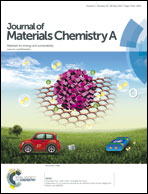High-temperature failure behaviour and mechanism of K-based additives in Li–Mg–N–H hydrogen storage systems†
Abstract
We report the high-temperature failure behaviours and mechanisms of K-based additives in the Mg(NH2)2–2LiH hydrogen storage system. The onset of hydrogen release from a Mg(NH2)2–2LiH–0.08KF sample is approximately 80 °C; this is a 50 °C reduction in comparison with the pristine Mg(NH2)2–2LiH. However, the positive effects of K-based additives disappear when the hydrogen release and uptake of the KF-added Mg(NH2)2–2LiH samples are performed at higher temperatures (>200 °C). The change in the crystal structure of the dehydrogenation product, the enlargement in the grain and particle sizes of the dehydrogenation/hydrogenation products, and the increase in the inhomogeneous degree of mixing and distribution of K-based additives should be the three most important reasons for the increased operating temperature during the follow-up cycles. In particular, the ability of K-based additives to lower the operating temperature for hydrogen storage in the Mg(NH2)2–2LiH system can be sufficiently recovered after ball milling. Therefore, the failure of K-based additives after high-temperature treatment is only phenomenological instead of being natural. Strictly limiting the dehydrogenation/hydrogenation of the K-added Mg(NH2)2–2LiH system at lower temperatures is critical for maintaining the superior effect of K-based additives.


 Please wait while we load your content...
Please wait while we load your content...